Champion operator rates Chafer and Bateman self-propelleds
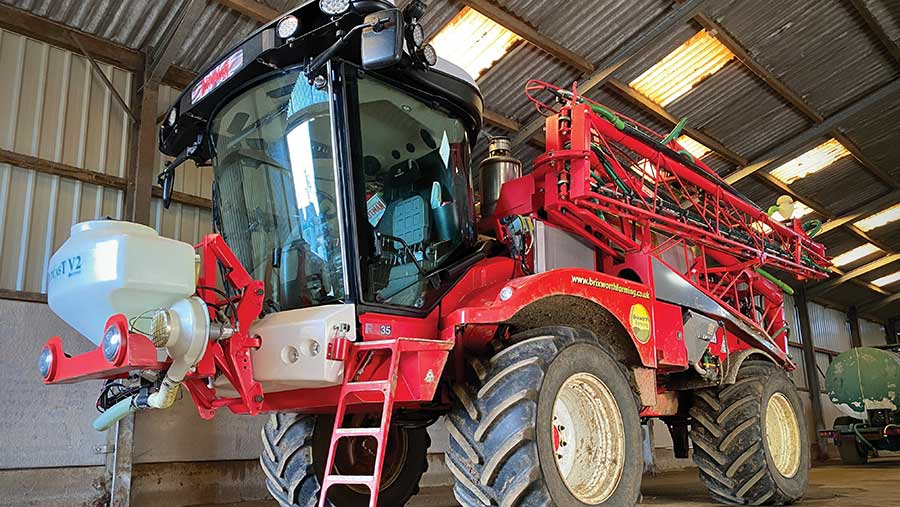 Bateman RB35 © MAG/Oliver Mark
Bateman RB35 © MAG/Oliver Mark Buyers of the biggest self-propelled sprayers are being seduced by a seemingly ever-growing list of optional extras that promise to improve accuracy, spray efficacy and ease of use.
The pinnacle of these, in terms of price and sophistication, is pulse-width modulation (PWM).
This fancy system uses electric solenoids on each nozzle body to flicker the flow of liquid on and off at super-high frequency, thereby maintaining consistent pressure and droplet size, irrespective of forward speed.
See also: Driver’s view: Steve May’s trailed John Deere R962i sprayer
It also brings with it turn compensation and single-nozzle shut-off, both of which make for an appealing tonic to the soaring cost of plant protection products.
Business facts
- Company Brixworth Farming, Brixworth, Northamptonshire
- Area covered 2,200ha arable joint venture, stewardship and contracting services
- Crops grown Wheat, oats, beans and canary seed
- Sprayers used Chafer Interceptor 5000 and Bateman RB35
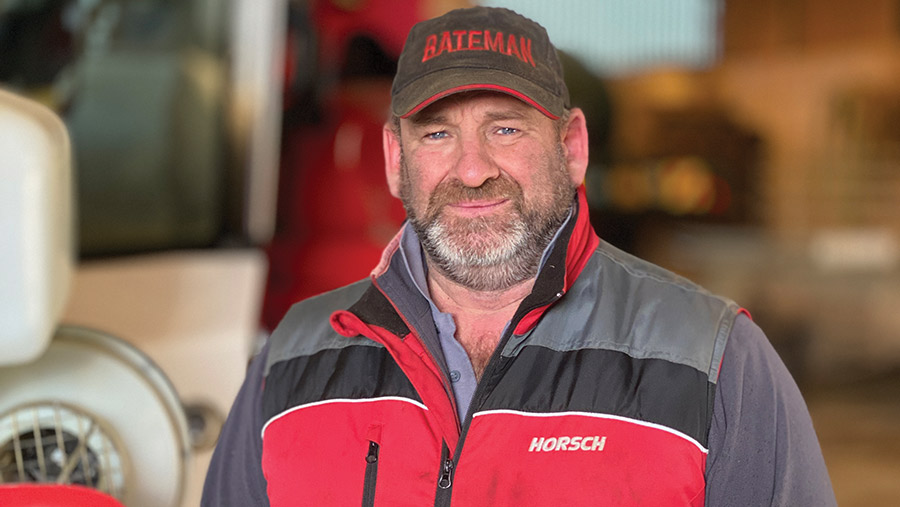
Mark Jelley © MAG/Oliver Mark
However, the true value of PWM remains hotly debated among spraying aficionados and, with average costs hovering around £1,000/m, questions remain as to whether the initial outlay can ever be fully recovered.
One outfit well placed to assess its merits is Brixworth Farming, an arable joint venture and contracting business based in Northamptonshire.
After several years of PWM procrastination, it finally took the plunge in 2020 when it specced Raven’s Hawkeye system on a new 5,000-litre, 36m Chafer Interceptor, which it runs alongside a fairly standard 2018 Bateman RB35.
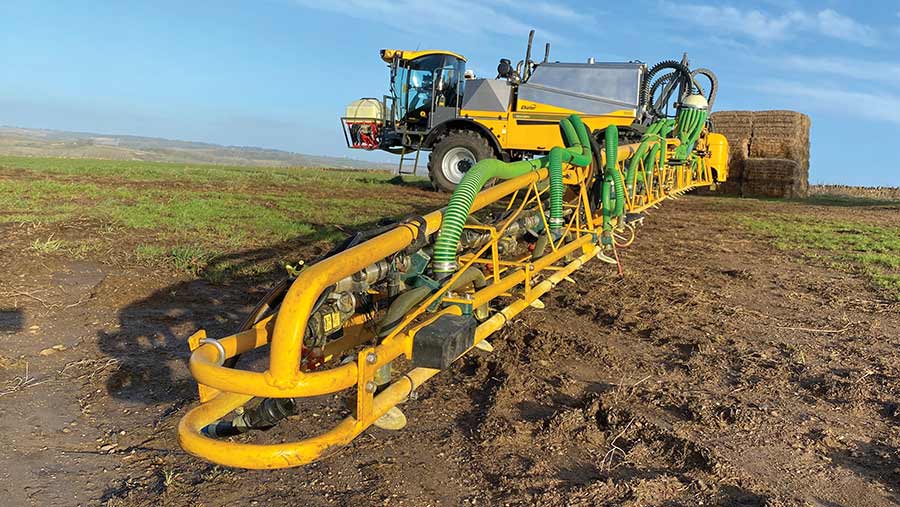
Chafer Interceptor © MAG/Oliver Mark
To find out whether the investment was worthwhile, we caught up with the firm’s lead sprayer operator and reigning Farm Sprayer Operator of the Year, Mark Jelley.
Is PWM worth the money?
Three years on, we’re still slightly in the dark about its true value.
Investing in expensive technology always comes with a degree of risk, but we desperately needed a more effective way of managing high grassweed pressure.
The priority was to get the right amount of product applied on every part of every field, particularly with regards to pre-emergence herbicides. Any added chemical savings were going to be a bonus rather than an objective.
The best part is the turn compensation element, which alters the application rate from each nozzle to account for variations in forward speed along the boom.
Headlands make up about 50% of our farmed area and there are plenty of in-field obstacles, so in some cases we were previously double or even triple dosing on the inside of the boom.
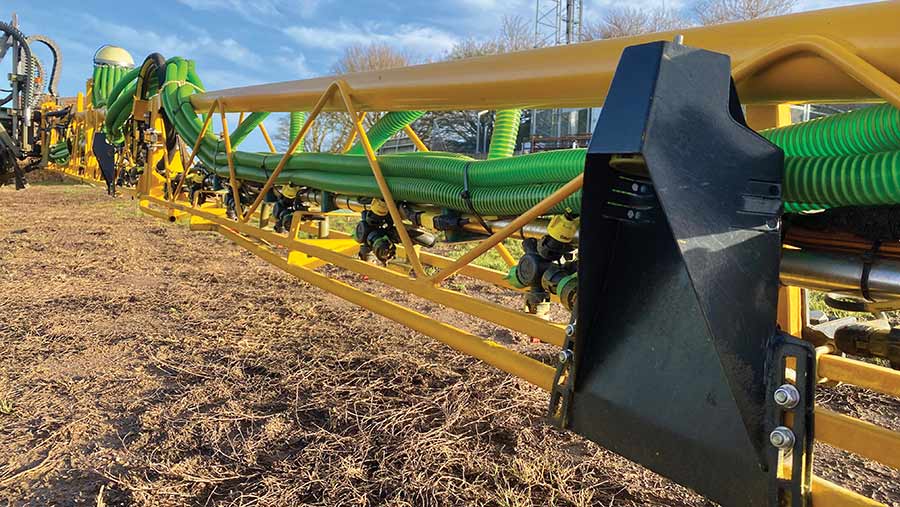
Norac boom levelling © MAG/Oliver Mark
And, at the same time, the outer sections were underdosing, which was only exacerbating grassweed issues.
We’ve noticed a significant reduction in scorch after applying plant growth regulators and also following liquid fertiliser, which we do on about one-quarter of the acreage.
There have certainly been some improvements in weed control, though it’s difficult to ascertain how much of that is down to the spraying and how much is the result of other changes we’ve made.
The simplest way to look at it is that we haven’t rushed to get PWM retrofitted on the Bateman. The concept is good but, without grant funding to soften the blow, it’s a big whack of money.
We could probably get similar results from a system that automatically switches the nozzles to maintain application rate as forward speed changes.
It hasn’t been entirely faultless, either. Early on, we had problems with the little stainless-steel poppets that stop and start the flow of liquid.
They tended to get sticky due to a build-up of congealed product, so we’re now pretty religious about washing out every evening.
We’ve also suffered from low-voltage warnings when spraying in the evening with all the lights on. This gets worse when running the twin-motor Avadex applicator.
I’m told there’s a way of reducing the PWM power draw, so it’s something I need to do a bit of homework on.
What other extras are fitted?
The Chafer has pretty much everything. On the front, I’ve got a Techneat Avacast Twin Air applicator, with the pipes neatly routed around the side to spreader plates spaced at 50cm intervals on the boom.
We use 15kg bags of Avadex, each of which is enough for 1ha. As the hopper has capacity for 25 of them, refilling is perfectly matched to the 5,000-litre spray tank when I’m pre-emming at 200 litres/ha.
I’ve also got a Yara N-Sensor for variable-rate fertiliser. For this, the agronomist provides a target application rate, and the system tweaks it based on crop biomass.
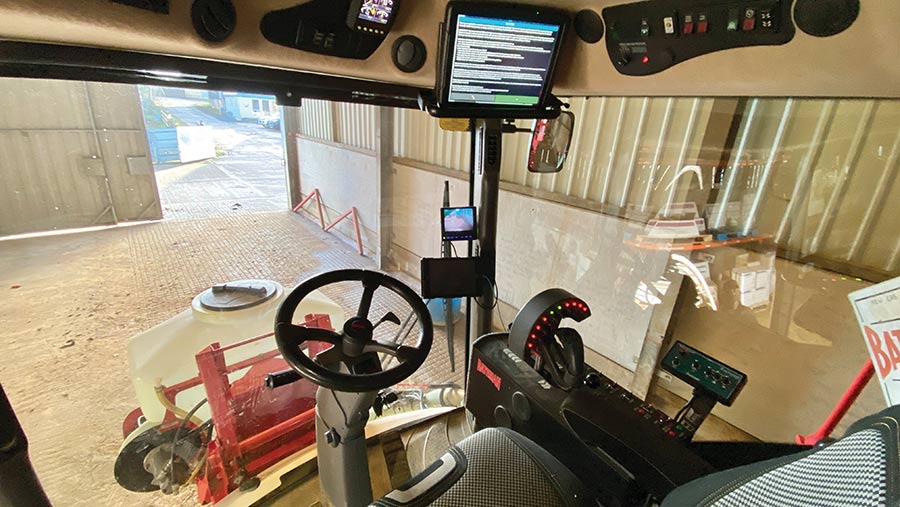
Bateman cab © MAG/Oliver Mark
We’ve got the same on the JCB Fastrac with a spinning disc spreader and, from my experience, the result is similar to using soil maps.
However, the sensors are currently mounted on the engine cowling and vibrate too much, so one of my jobs before spring is to rig up new brackets to fit them on the cab roof.
The other main extras are an on-board pressure washer hose and Topcon RTK guidance. As the screen for this is isobus compatible, I can use it to run the Raven Hawkeye software.
It also has an electronically controlled induction system. This means I can punch in the exact amount of liquid I want and pause the filling process to give me more time to load complicated tank mixes.
The Bateman has a fairly standard induction system, so if I’m slow to empty the containers I have to stop filling with clean water and recirculate the contents of the tank.
The washer jets don’t have quite as much pressure either, and the hopper is a bit on the small side.
The only extra on the Bateman is a Techneat Outcast V2 slug pelleter that feeds three spinning discs on the boom.
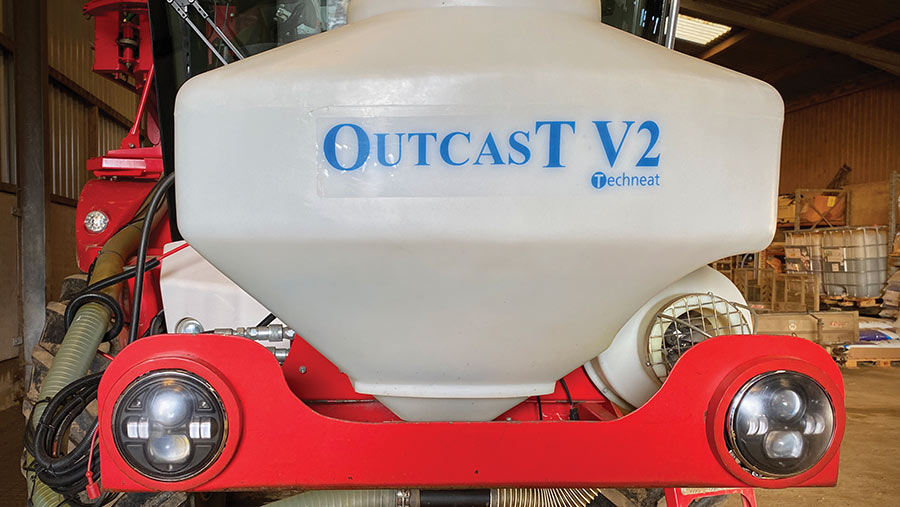
© MAG/Oliver Mark
We’ve recently been using this to trial sowing clover under winter cereals, with the aim of suppressing grassweeds. Sadly, last year it wasn’t particularly effective because it was too dry and the clover struggled to establish.
Which is best to drive?
I’d pick the Bateman because it’s simple, more stable and the boom unfolds quicker.
It’s like a go-kart to drive, and the hydraulic suspension seems to do a better job of managing body roll than the air bags on the taller Chafer.
The one thing I’d change is the tyres. For most of the season it runs on 710/55 R30s, which are a little too wide.
There’s no doubt they spread the weight well, but they struggle for traction, stick well beyond the mudguards and fling debris onto the boom.
The Chafer has slightly narrower VF 620/75 R30 Michelin AxioBib 2s. They put four cleats on the ground at 14psi and seem to find far more grip than the 710s.
Handily, Chafer also fits sheets that protect the nozzles from mud.
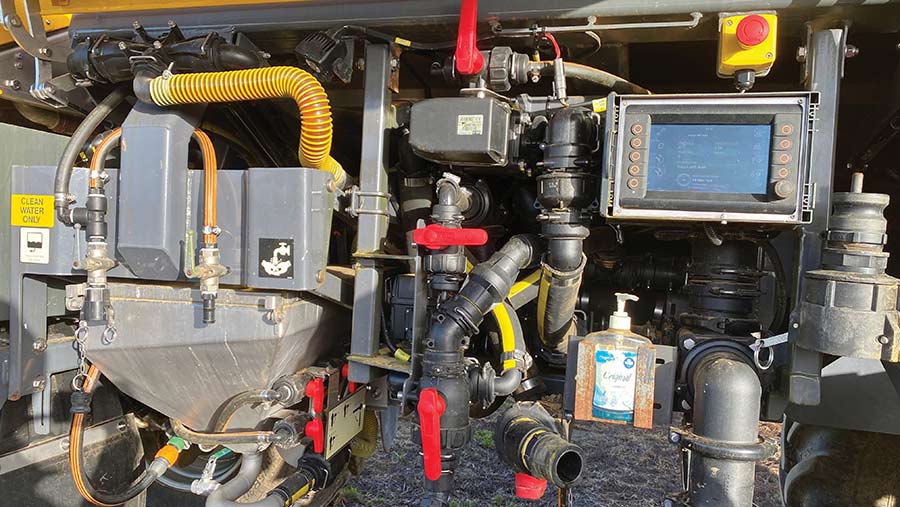
Chafer Interceptor 5000 induction system © MAG/Oliver Mark
How have they performed?
The Bateman has been faultless, bar the odd diaphragm in the Ramsey valve. We keep these in stock and I can change one in about half an hour.
We’ve replaced a few boom bushes too, usually after its annual MOT.
The Chafer is a brilliant machine when it’s running – the cab is comfortable, the PWM system is accurate, and the electronically controlled induction system is easy to use.
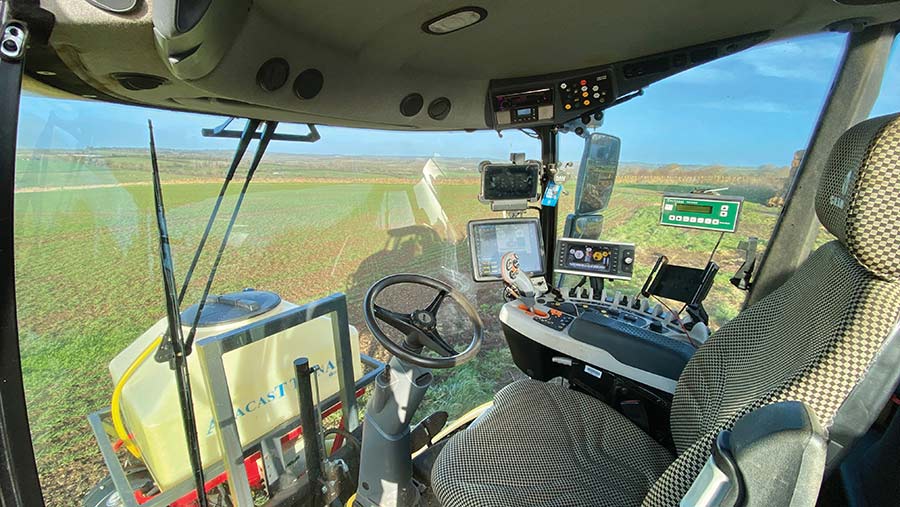
Chafer Interceptor 5000 cab © MAG/Oliver Mark
However, it has suffered from a few too many mechanical problems.
In its time with us we’ve replaced the hydraulic pump and two valve blocks, the engine crankshaft and an ECU.
For those reasons, we’ll probably look to move it on before the Bateman.
As we’ve recently reduced the arable area due to changes in various farm policies, it might be that we replace it with a trailed machine.
What are your go-to nozzles?
Most of the work is done with red Teejet Turbo Twin Jets.
Pre-emergence sprays go on at 200 litres/ha through twin caps, which have a Defy on one side and a normal flat fan on the other.
These are currently blues, which would normally suffice at 12kph.
But you generally need to go a nozzle bigger with PWM, and the blues are working at a high duty cycle (the amount of time the nozzle is open versus closed) of 80-90%.
Swapping to reds should bring that down to the target 65-70% range.
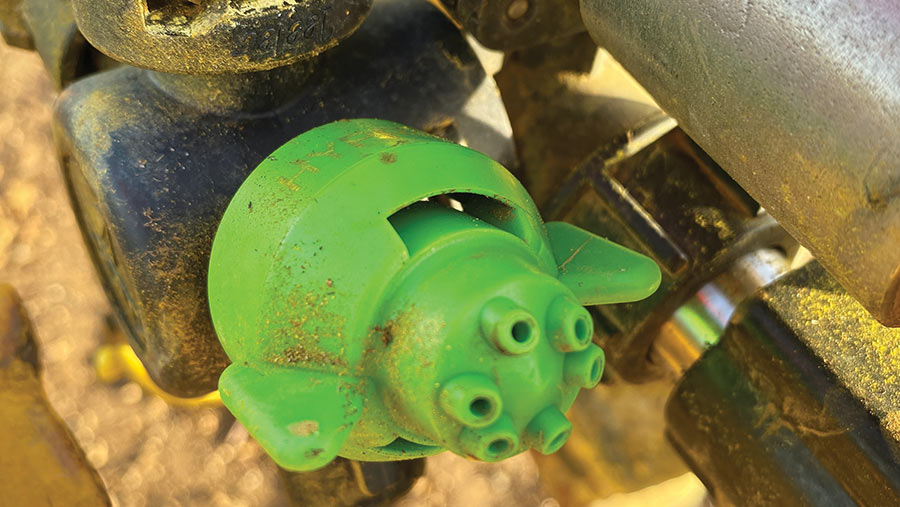
Liquid fertiliser nozzle © MAG/Oliver Mark
For liquid fertiliser, I’ve switched from an umbrella-type nozzle, which was catching too much wind, to a Hypro FC-ESI light green stream nozzle.
Both machines have Norac boom levelling. The downside with the Bateman is that it’s only a three-sensor system, with the outer two on the wing tips.
This means that it doesn’t work when I’ve got the booms folded to 24m for spraying small plots.
Bateman RB35 specs
- Year 2018
- Hours 5,000
- Engine Six-cyl John Deere
- Power 225hp
- Transmission Hydrostatic
- Road speed 40kph
- Tank size 4,000 litres
- Nozzles Five-way body
- Auto shut-off 12 sections
- Boom levelling Three-sensor Norac
- Guidance Topcon RTK
- Boom width 36m
- Main tyres 710/55 R30
Bateman RB35 likes and gripes
Likes
- Reliable
- Good backup
- Simple to drive
Gripes
- Slightly awkward cab access
- Engine dipstick hard to get at
- Container washer jets lack power
Chafer Interceptor 5000
- Year 2020
- Hours 3,200
- Engine Six-cyl Deutz
- Power 215hp
- Transmission Bosch Rexroth hydrostatic
- Road speed 50kph
- Tank size 5,000 litres
- Nozzles Five-way body
- Auto shut-off Single-nozzle PWM
- Boom levelling Five-sensor Norac
- Guidance Topcon RTK
- Boom width 36m
- Main tyres VF 620/75 R30
Chafer Interceptor 5000 likes and gripes
Likes
- Comfortable cab
- Accessible engine via gantry
- Sheets protect nozzles behind wheels
Gripes
- Reliability issues
- Less stable on the road
- Boom slow to unfold

